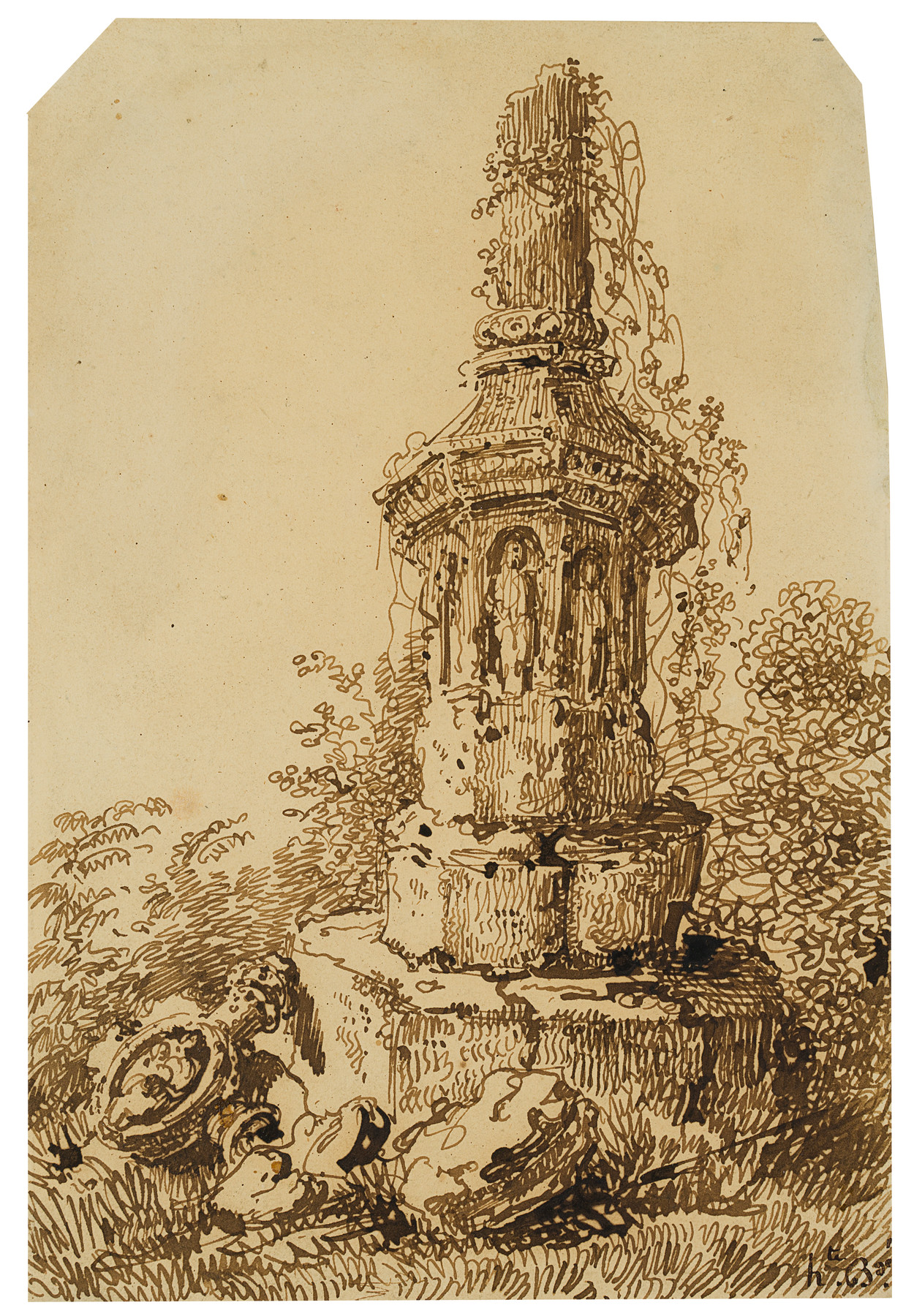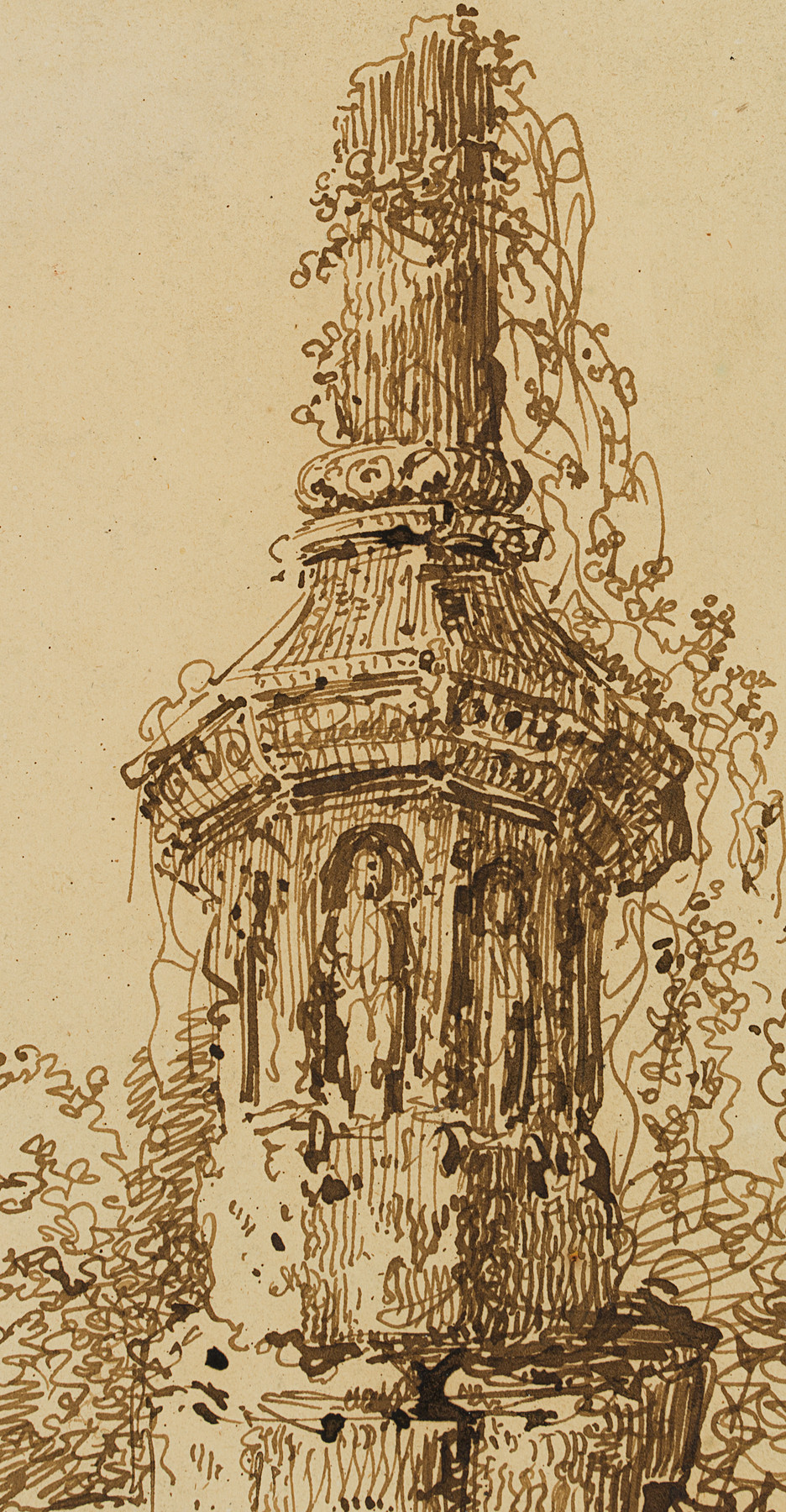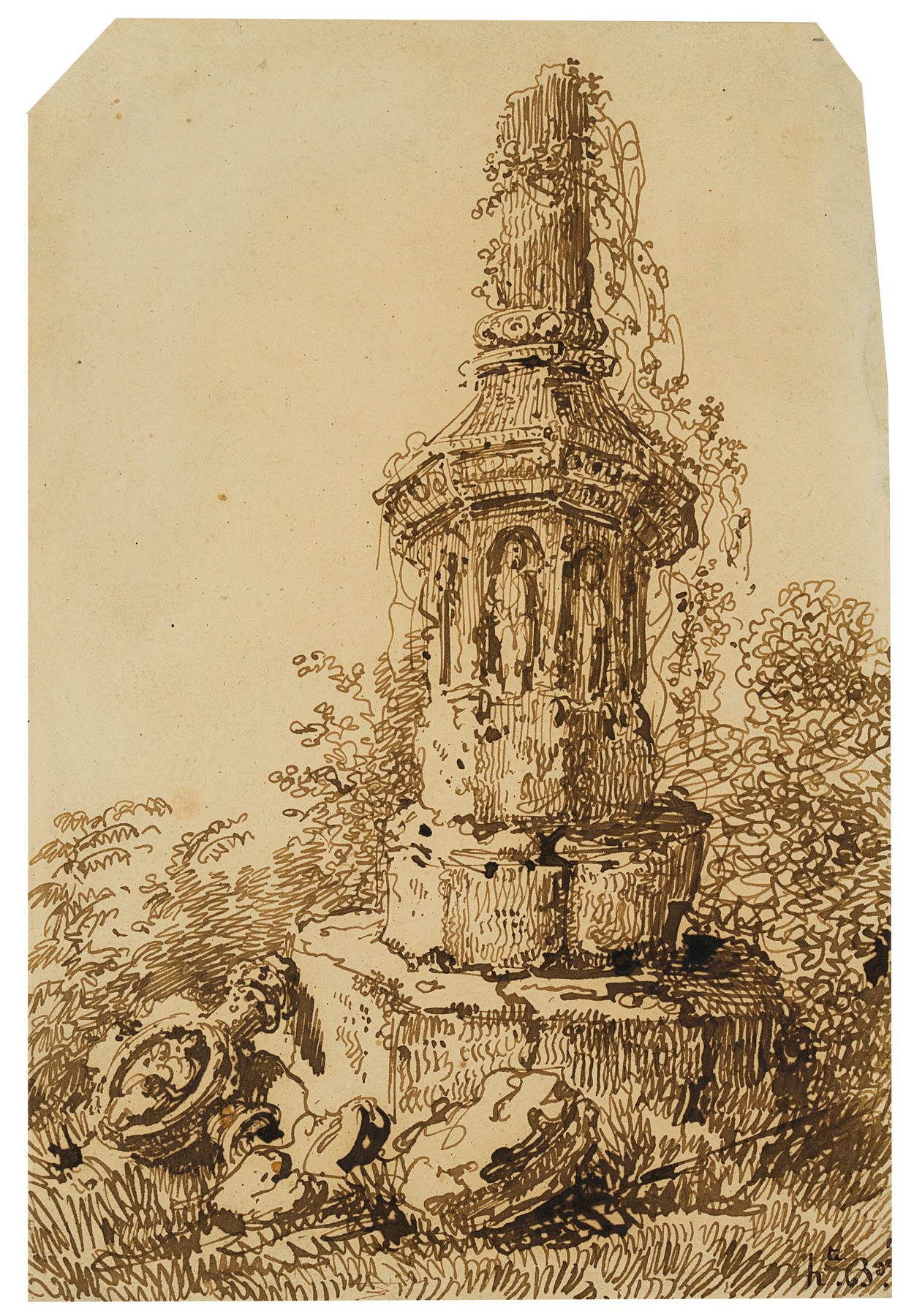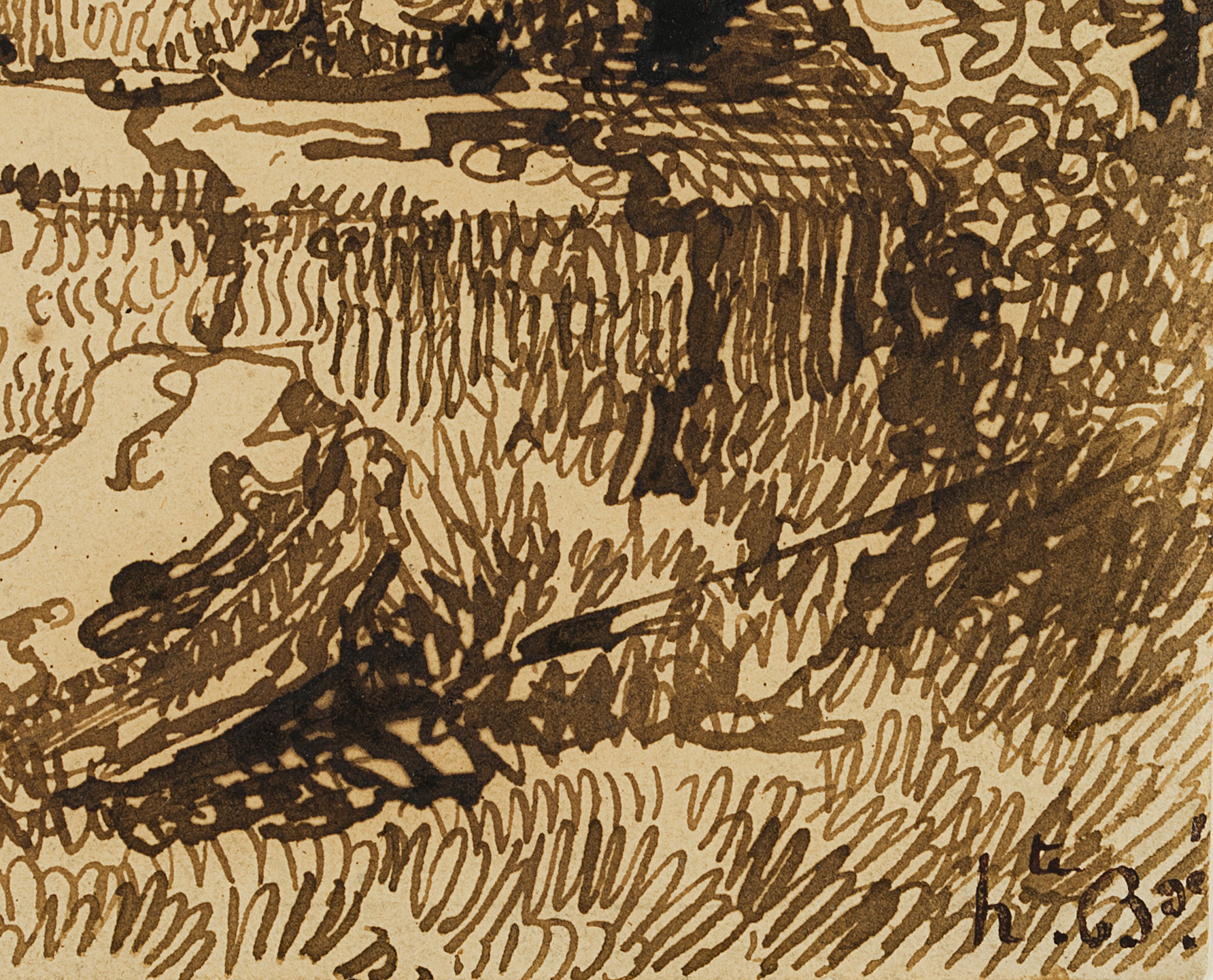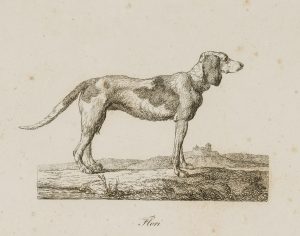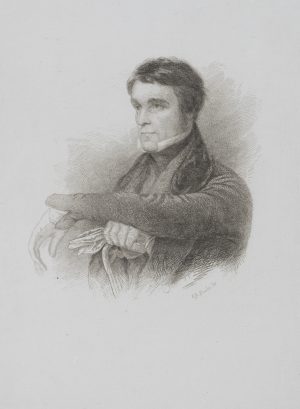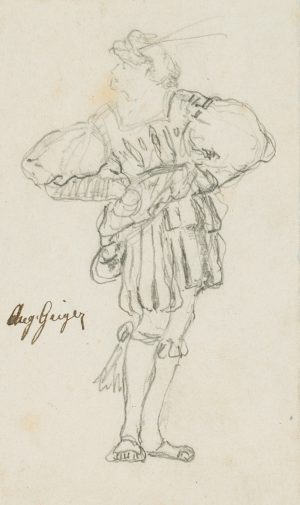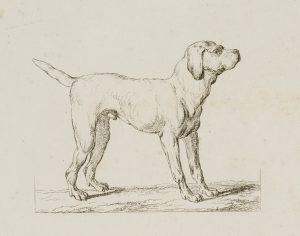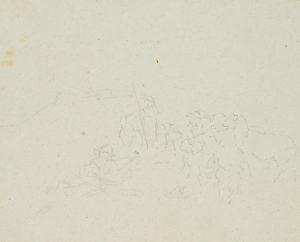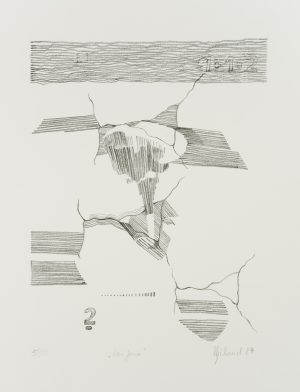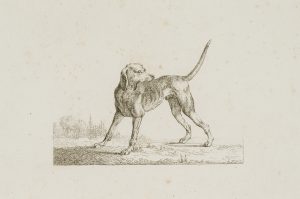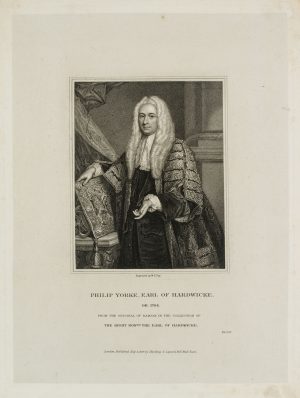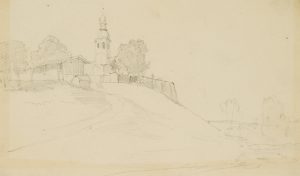Hippolyte Bellangé (1800 Paris – 1866 ebd.), Überwuchertes Denkmal, um 1850, Federzeichnung
- Technik: Federzeichnung auf Papier
- Bezeichnung: unten rechts monogrammiert: “ht. Bgé”
- Datierung: um 1850
- Beschreibung: Was malt ein Schlachtenmaler, wenn er keine Schlachten malt? Hippolyte Bellangé gehörte zu den bedeutendesten Schlachtenmalern im Frankreich von Louis-Philippe und Napoleon III. Ein riesiges Œuvre, gefüllt mit zigtausenden Soldaten, Waffen und Pferden, wo der Mensch zur Masse wird. Hochgefeiert und hochdekoriert wird er für diese Darstellungen der Megaevents. Was ihm aber zwischen all dem gepinselten Säbelrasseln und getupftem Pulverdampf nicht abhanden gekommen ist, ist der Blick für die Details. Im Weitwinkel konnte er Massenschlachten lebendig werden lassen, aber wie unter einem Mikroskop war er auch in der Lage, den einzelnen Soldaten in seinem Schicksal wahrzunehmen. Wie sein Freund Nicolas-Toussaint Charlet stellte er das Leben der Soldaten abseits der Schlacht in zahlreichen Lithographien und Zeichnungen dar, mal melancholisch mitfühlend, mal karikierend distanziert. Immer aber mit dem Blick für das Detail, was sich bei ihm nicht nur auf die Äußerlickeiten beschränkte, sondern mitunter auch psychologische Züge annahm.
Nun aber zurück zur Eingangsfrage: Was malt er nun? Zunächst einmal ziemlich wenig Anderes. Selbst wenn er ins Genre abgleitet, so findet sich doch immer irgendwo eine Uniform, die auf die eine oder andere Weise ihren Weg ins Bild gefunden hat. Um so erstaunlicher ist unsere Zeichnung, die in jenem unvergleichlich nervösen Strich ein zerstörtes Stück christlicher Kunst zeigt. So lange ist es schon verfallen und vergessen, dass die Natur ihre zarten Finger nach ihm ausgestreckt hat. Das Kreuz liegt gebrochen am Boden. Kaum vorstellbar, dass es nochmals zu altem Glanz zurückkehren kann.
Weiß man um Bellangés fokussierte Darstellungen, in denen die geschundenen und heimgekehrten Soldaten in den Blick genommen werden, so kommt man nicht umhin auch in diesem geborstenen Denkmal eine emotionale Konnotation zu erkennen. Gebrochen und einsam: Das sind Vokabeln, die sich auch auf die Soldaten übertragen lassen.
Neben dieser emotionalen Dimension fasziniert an diser kleinen und ungemein freien Zeichnung aber besonders der zitternde Strich, der nirgends Halt macht und wie getrieben über das Blatt huscht und aus dem sich nur langsam die klaren Formen abzeichnen, nur um im nächsten Moment wieder von einer weiteren Linienzuckung verschluckt zu werden. Dieser dynamische, fast atmende Prozess macht den besonderen Reiz dieser für Bellangé ungewöhnlichen, aber gerade dadurch spannenden Zeichnung aus. |af| - Schlagworte: Denkmal, Wegkreuz, Friedhof, Kleinarchitektur, Bildhauerei, Säule, Antike, Figur, Ruine, Vanitas, Architektur, Frankreich, Romantik, 1850-1899
- Größe: 19,5 cm x 13,3 cm
- Zustand: Guter Zustand. Leicht gebräunt. Die Ränder sind unregelmäßig beschnitten. Am rechten Rand oben mit kleiner Restaurierung.
English Version:
Hippolyte Bellangé (1800 Paris – 1866 ibid.), Overgrown monument, c. 1850, Pen drawing
- Technique: Pen drawing on Paper
- Inscription: monogrammed lower right: “ht. Bgé”
- Date: c. 1850
- Description: What does a battle painter paint if he does not paint battles? Hippolyte Bellangé was one of the most important battle painters in the France of Louis-Philippe and Napoleon III. A huge oeuvre, filled with thousands of soldiers, weapons and horses, where man becomes mass. He is highly celebrated and highly decorated for these depictions of mega-events. What he has not lost, however, between all the painted sabre-rattling and dabbed gun smoke, is an eye for detail. In wide-angle, he was able to bring mass battles to life, but as if under a microscope, he was also able to perceive the individual soldier in his fate. Like his friend Nicolas-Toussaint Charlet, he depicted the lives of soldiers away from battle in numerous lithographs and drawings, sometimes melancholically compassionate, sometimes caricaturedly distanced. But always with an eye for detail, which in his case was not limited to the exterior, but sometimes also took on psychological traits.
But now back to the initial question: What does he paint now? First of all, very little else. Even when he slips into genre, there is always a uniform somewhere that has found its way into the picture in one way or another. All the more astonishing is our drawing, which in that incomparably nervous stroke shows a destroyed piece of Christian art. It has been decayed and forgotten for so long that nature has stretched out her delicate fingers to it. The cross lies broken on the ground. It is hard to imagine that it can return to its former glory.
If one knows about Bellangé’s focussed depictions in which the maltreated and returned soldiers are taken into consideration, one cannot help but recognise an emotional connotation in this broken monument. Broken and lonely: these are words that can also be applied to the soldiers.
In addition to this emotional dimension, what is particularly fascinating about this small and extraordinarily free drawing is the trembling stroke that does not stop anywhere and flits across the page as if driven, from which the clear forms only slowly emerge, only to be swallowed up by another twitch of line in the next moment. This dynamic, almost breathing process is the special charm of this drawing, which is unusual for Bellangé but exciting precisely because of this. |af| - Keywords: Monument, wayside cross, cemetery, small architecture, sculpture, column, antiquity, figure, ruin, vanitas, 19th century, Romanticism, Architecture, France,
- Size: 19,5 cm x 13,3 cm (7,7 x 5,2 in)
- Condition: Good condition. Slightly browned. Margins irregularly trimmed. At the upper right margin with small restoration.

